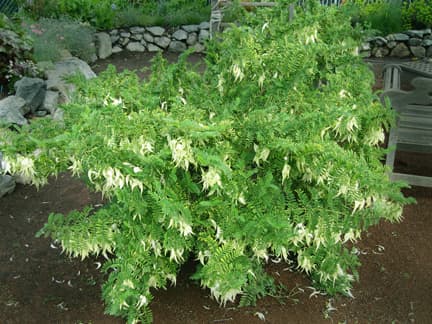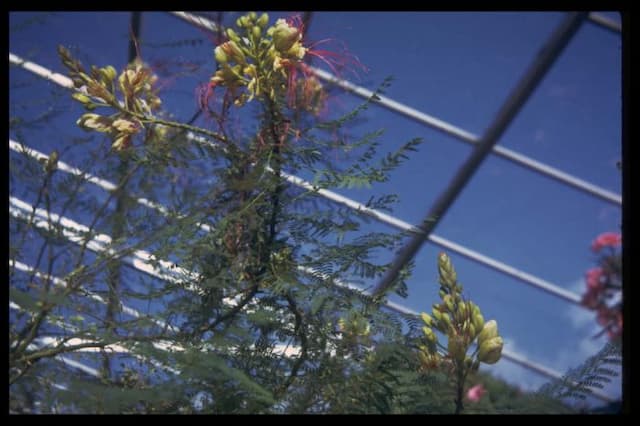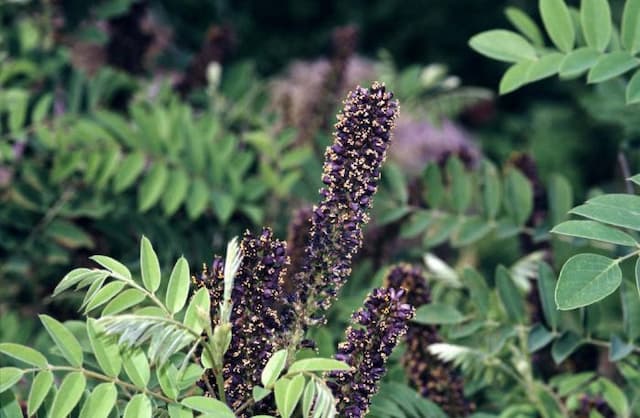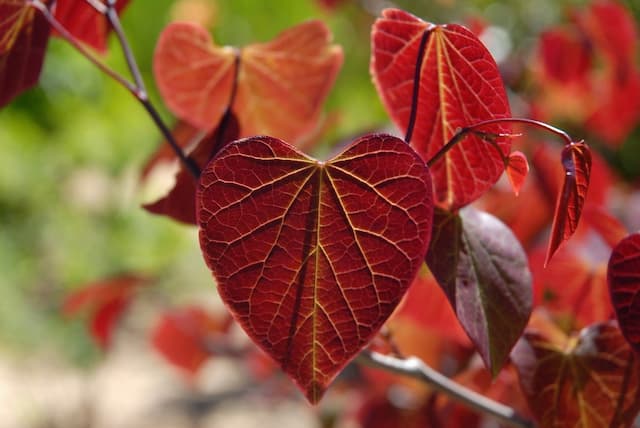Bean (runner) 'Painted Lady' Phaseolus coccineus 'Painted Lady'

ABOUT
'Painted Lady' is a dense, climbing perennial, often grown as an annual. Red and white scented flowers appear in the summer, followed by medium-sized, tender pods throughout the summer
About this plant
 Names
NamesFamily
Fabaceae.
Synonyms
Scarlet Runner Bean, Painted Lady Runner Bean, Multiflora Bean, Flowering Bean, Dutch Case-knife Bean.
Common names
Phaseolus multiflorus, Phaseolus coccineus.
 Characteristics
CharacteristicsLife cycle
Annuals
Foliage type
Deciduous
Color of leaves
Green
Flower color
Red
Height
10 feet (3 meters)
Spread
3 feet (0.9 meters)
Plant type
Climber
Hardiness zones
2
Native area
America
Benefits
 General Benefits
General Benefits- Edible Pods: Phaseolus coccineus 'Painted Lady' produces edible pods that can be eaten raw or cooked, adding nutritional variety to the diet.
- Ornamental Value: With its striking red and white flowers, it serves as an attractive addition to gardens and landscapes.
- Attracts Pollinators: The vibrant flowers attract bees and butterflies, which help pollinate other plants in the garden.
- Nitrogen Fixation: As a legume, it enriches the soil by fixing nitrogen, thereby reducing the need for chemical fertilizers.
- Vertical Growth: It grows as a climbing vine, which can save space in small gardens and can be used to create living screens.
- Versatility: The beans can be harvested young and tender or allowed to mature for dry beans, offering culinary versatility.
- Food Security: The ability to grow and harvest one's own beans contributes to household food security.
- Economic Value: The beans can be sold or traded, providing economic value to the grower.
- Companion Planting: It can be used in companion planting to enhance the growth of other plants and deter pests.
- Cultural Significance: It has historical and cultural significance in many regions, often being grown in traditional gardens and recipes.
 Medical Properties
Medical Properties- Antioxidant Activity: The seeds contain compounds that can act as antioxidants, which help prevent cellular damage from free radicals.
- Protein Source: As a legume, Phaseolus coccineus offers a significant amount of protein which is important for muscle repair and immune function.
- Fiber Content: The high fiber content of the beans can aid in digestion and help maintain a healthy gut.
- Diuretic Properties: The plant has been traditionally used for its diuretic effects to help in the removal of excess water and toxins from the body.
- Blood Sugar Regulation: Some evidence suggests that Phaseolus coccineus may help in regulating blood sugar levels, although further research is required.
 Air-purifying Qualities
Air-purifying QualitiesThis plant is not specifically known for air purifying qualities.
 Other Uses
Other Uses- As a cover crop, Phaseolus coccineus 'Painted Lady' can be planted to improve soil fertility by fixing nitrogen, which benefits subsequent crops.
- The sturdy vines of the Scarlet Runner Bean can be used as natural screens or privacy barriers in gardens and patios when trained along fences or trellises.
- The flowers of Scarlet Runner Bean can be used for ornamental purposes in floral arrangements due to their vibrant colors and attractive shape.
- When dried, the empty pods of Scarlet Runner Bean can be utilized in craft projects or as part of dried decorative displays.
- The plant's beans can be used as educational tools in schools for projects on plant growth, seed germination, and pollination.
- In landscaping, Scarlet Runner Bean can be used to add vertical interest to gardens, drawing the eye upward with its climbing habit.
- The beans of Scarlet Runner Bean, when polished, have been occasionally used in jewelry making, particularly for creating unique, plant-based beads.
- The lush foliage of Scarlet Runner Bean provides habitat and food for pollinators and beneficial insects, contributing to biodiversity in the garden.
- Scarlet Runner Bean can be planted alongside other crops as a companion plant to attract pollinators and improve pollination rates for vegetables and fruits.
- In traditional dye-making processes, the various parts of the Scarlet Runner Bean plant have been used to produce natural dyes for textiles.
Interesting Facts
 Feng Shui
Feng ShuiThe Scarlet Runner Bean is not used in Feng Shui practice.
 Zodiac Sign Compitability
Zodiac Sign CompitabilityThe Scarlet Runner Bean is not used in astrology practice.
 Plant Symbolism
Plant Symbolism- Beauty and Elegance: The 'Painted Lady' variety of Phaseolus coccineus, commonly known as the Scarlet Runner Bean, is known for its striking red and white flowers, symbolizing beauty and elegance.
- Vitality and Life Force: As a hardy and vigorous plant, Scarlet Runner Beans are often associated with vitality and the life force, embodying growth and robust health.
- Passion and Love: The rich red color of its blooms is commonly linked with passion and love, making it a plant that can represent strong emotions and affection.
- Nurturance and Support: As a bean plant, it symbolizes nurturance and support, reflecting its role as a food source and its ability to enrich the soil with nitrogen.
- Connection and Relationships: The plant's climbing nature allows it to intertwine with structures and other plants, representing the interconnectedness of relationships and community.
 Water
WaterThe Scarlet Runner Bean 'Painted Lady' prefers consistent moisture, so water it thoroughly once a week with about 1 gallon of water per plant. During hot, dry spells, you may need to water twice a week. It's important to avoid overhead watering, as this can promote disease; instead, water at the base of the plant. Ensure the soil is well-drained to prevent waterlogging. Always check the soil before watering; it should be moist but not saturated.
 Light
LightScarlet Runner Beans 'Painted Lady' thrive best in full sun, requiring at least 6 hours of direct sunlight daily. Place them in a spot where they can receive unfiltered sunshine for most of the day. If you're growing them indoors, a south-facing window is an ideal location to ensure they receive adequate light.
 Temperature
TemperatureScarlet Runner Beans 'Painted Lady' prefer a temperate climate and will grow best when daytime temperatures are between 60°F and 70°F. They can withstand a minimum temperature of around 50°F; however, temperatures below that can harm the plant. The maximum temperature for healthy growth is around 90°F, but prolonged heat may stress the plant.
 Pruning
PruningPruning Scarlet Runner Beans 'Painted Lady' is mainly done to encourage airflow and manage size. Trim off any dead or damaged stems throughout the season. After the first flush of beans is harvested, you can lightly prune the plant to stimulate new growth. The best time to prune is in the late afternoon or early evening when the plant is less stressed.
 Cleaning
CleaningAs needed
 Soil
SoilScarlet runner bean prefers a rich, well-drained soil mix with plenty of organic matter, such as compost or well-rotted manure. A pH range of 6.0 to 6.8 is ideal, promoting the best growth and flowering. Ensure the soil allows for proper drainage to avoid waterlogging.
 Repotting
RepottingScarlet runner beans typically do not need repotting as they are annual plants. Plant seeds directly into the garden each year or start new plants in pots that can accommodate their full growth for the season.
 Humidity & Misting
Humidity & MistingScarlet runner beans thrive in moderate humidity levels but are quite adaptable and can tolerate a range of humidity conditions found in typical outdoor environments. Aim to maintain natural outdoor humidity without the need for adjustments.
 Suitable locations
Suitable locationsIndoor
Place in bright indirect light, support with trellis.
Outdoor
Full sun, well-draining soil, space 15-20cm apart.
Hardiness zone
5-11 USDA
 Life cycle
Life cycleThe life of the Scarlet Runner Bean 'Painted Lady' begins as a seed, which after sowing in well-drained soil and with adequate warmth, germinates within a week or two. Upon germination, the seedling emerges with two cotyledons followed by true leaves, growing into a climbing vine that requires support. During the vegetative growth stage, the plant develops a robust stem and foliage, thriving in full sun with regular watering. The flowering stage comes next, typically in summer, when the plant produces bright red and white bicolor flowers that are attractive to pollinators. Following pollination, the flowers develop into elongated green pods containing the beans which can be harvested when the pods are young for snap beans or left to mature on the vine for shell or dry beans. Finally, once harvested or left to dry on the plant, the seeds can be collected for future planting, completing the life cycle.
 Propogation
PropogationPropogation time
Spring-Early Summer
Propogation: The most popular method of propagating the Scarlet Runner Bean 'Painted Lady' is by direct sowing of seeds. In temperate regions, the ideal time for sowing is late spring, once the soil has warmed up and there is no risk of frost, typically after the last frost date. Sow the seeds 1 to 2 inches deep, spacing them about 4 to 6 inches apart in rows that are spaced 18 to 24 inches apart. Seeds should be planted in well-drained soil and watered thoroughly at the time of planting. The seedlings tend to emerge within 7 to 14 days. As climbers, they will require support, so it is advisable to place poles or a trellis at the time of planting to accommodate their growth habit. This direct seeding method is favored by gardeners for its simplicity and effectiveness in producing vigorous plants.









